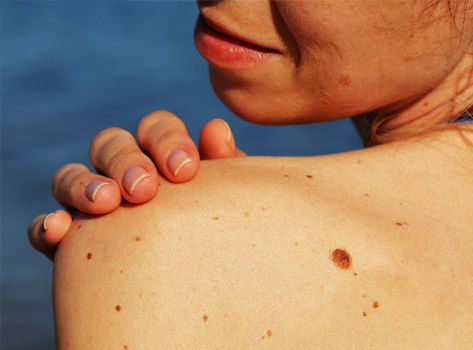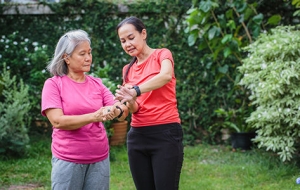
In most parts of the country, the weather is getting warmer, people are spending more time outdoors and sun exposure and skin cancer are greater concerns. That’s why May is a perfect time for Melanoma and Skin Cancer Awareness Month.
There are many types of skin cancers, all named after the cells in the skin that become cancerous. The three most common are melanoma and non-melanoma basal cell and squamous cell skin cancer. Melanoma (which develops when melanocytes, the cells that produce pigment or skin color, grow out of control) is less common, but more dangerous because it has the highest risk of spreading beyond the skin if not treated early.
So how do you spot melanoma? Eric D. Whitman, MD, medical director for Atlantic Health System Cancer Care, offers the following information about the early warning signs of this dangerous skin cancer and steps you can take to reduce your risk.
The ABCDEs of Melanoma
Brown spots, moles or what you may think are freckles or birthmarks that grow, change or will not heal are the biggest indicators of melanoma. Other signs to look for are classified as the ABCDEs of melanoma:
- Asymmetry: One half does not match the other; they are unalike and not even or round
- Border: The edges are uneven, irregular or jagged, not smooth
- Color: It’s uneven, with different shades of brown, tan or black throughout, or it darkens over time
- Diameter: Rule of thumb is anything over 1/4-inch or 6mm in diameter (the size of a pencil top eraser), but can be smaller
- Evolving: Any change in size, shape, color, elevation or condition such as bleeding, crusting or itching should be examined
The Ugly Duckling Rule
According to Dr. Whitman, the most useful early warning sign of melanoma is called the Ugly Duckling rule.
Just like the classic children’s tale by the same name, the Ugly Duckling refers to the one that stands out because it looks different. But contrary to the fairy tale’s moral, when it comes to skin cancer, the ugly duckling should not be accepted because in this case, different can be a cause for concern.
“The main thing is, if you have a mole that’s different than all the others on your body – either in size or appearance – or one that’s changed from how it used to look and feel, you should consult a dermatologist right away.”

Top Risk Factors and Prevention Tips
There are a few risk factors that may increase your chances of developing skin cancer. These include:
- having fair skin and being sun-sensitive (i.e., you burn easily)
- excess UV exposure in youth (from natural sunlight or tanning beds)
- genetics/family history
- personal history with skin cancer (once you’ve had one type, you’re at a higher risk for melanoma in the future)
While you may be predisposed to melanoma or other skin cancers, there are things you can do to reduce your risk. Dr. Whitman suggests taking the following actions:
- Wear sunscreen daily (SPF 30 or higher) and reapply when washed off by water or sweat.
- Avoid midday sun, especially if you are prone to burning.
- Have an annual skin check with a trained dermatologist, especially if you are at a higher risk.
- Do self-exams occasionally, looking for changes.
“You don’t have to go to extremes,” cautions Dr. Whitman. “It’s just as unhealthy to completely avoid sun exposure because your body needs vitamin D to function. Just be careful, appreciate the risks and keep a watchful eye.”
The five-year survival rate for people in the U.S. whose melanoma was detected early is 99%, according to the Skin Cancer Foundation, so early detection is crucial. The key thing to remember: When in doubt, check it out; if it looks different, changes or won’t heal, have it examined right away.
“Melanoma can occur on any part of the body, not just sun-exposed skin,” reminds Dr. Whitman. “Early detection is important for all skin cancers, but most importantly for melanoma.”
Be Proactive About Your Health
To stay safe and healthy, it's good to have a primary care provider who knows and understands your health history and wellness goals.
Related Articles
Your Healthy Summer Guide
Atlantic Health System is your healthy summer guide to a safe and fun season. From helpful tips to preventive and urgent care, we've got you covered for whatever summer brings.
Protect Your Skin from Sun Damage this Season
Summertime activities bring us out in the sun. Whether it’s time spent at the beach, pool, park, or garden, it’s important to protect your skin from the glare of ultraviolet (UV) rays -- and lower your risk of potential skin damage.
Avoid Heat Exhaustion this Summer
The summer heat and humidity sneak up on us. It is important to recognize the symptoms of heat exhaustion and heat stroke so you can protect yourself and those around you.
Focus on Summer Heart Health
Even a healthy heart can be put under stress when temperatures climb. Learn more about what factors may make someone particularly vulnerable to heat-related conditions.
5 Cool Tips to Prevent Heat-Related Illness
Learn 5 tips to help you stay cool and safe during hot and sticky summers and avoid heat-related illness.




